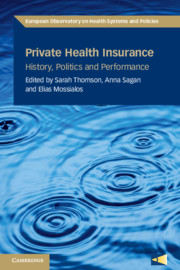In Prioritizing health: A prescription for prosperity, we measure the potential to reduce the burden of disease globally through the application of proven interventions across the human lifespan over two decades. By intervention, we mean actions aimed at improving the health of an individual. These range from public sanitation programs to surgical procedures and adherence to medication and encompass interventions recommended by leading institutions like the World Health Organization or national medical associations. We also examine the potential to reduce the disease burden from innovations over the same period.
06 d’octubre 2020
Health as a priority
05 d’octubre 2020
Health reform, a lost chance (once again)
30 MESURES PER ENFORTIR EL SISTEMA DE SALUT
In the midst of covid crisis, our government created a Comitè d’Experts per a la Transformació del Sistema Públic de Salut. It gave them 2 months to solve such a complex issue, and this is the result. The message is clear, the implementation fuzzy. My impression is that if the Parliament asked for a reform and we delivered a report 6 years ago and nothing happened, now that the government is leaving it is not the best moment to think about it. Nevertheless, health reform, public and private, is as relevant as it was 6 years ago, but unfortunately nobody is taking charge.
PS. Someday I'll explain what really happened, the enablers and the blockers, and why all this has still impact in the current situation.
04 d’octubre 2020
Integrated care as organizational innovation
Innovative Integrated Health And Social Care Programs In Eleven High-Income Countries
High-income countries face the challenge of providing effective and efficient care to the relatively small proportion of their populations with high health and social care needs. Recent reports suggest that integrated health and social care programs target specific high-needs population segments, coordinate health and social care services to meet their clients’ needs, and engage clients and their caregivers. We identified thirty health and social care programs in eleven high-income countries that delivered care in new ways. We used a structured survey to characterize the strategies and activities used by these programs to identify and recruit clients, coordinate care, and engage clients and caregivers. We found that there were some common features in the implementation of these innovations across the eleven countries and some variation related to local context or the clients served by these programs.
Needs segmentation, Patient coordination and Engagement are the crucial topics. More details inside the article.
03 d’octubre 2020
Specialty pharmaceuticals regulation
SPENDING REVIEW FASE II. ESTUDIO GASTO HOSPITALARIO EN EL SISTEMA NACIONAL DE SALUD
Airef has release a report on specialty pharmaceuticals in the National health service. This is a crucial issue to understand health expenditure, and the report helps a lot.
The ppt, here.
02 d’octubre 2020
Private health insurance landscape
Private health insurance: history, politics and performance
This is a collection of comparative case studies analysing the history, politics and performance of private health insurance globally and its implications for universal health coverage. An essential reading.
And these are the contents:
1 Why private health insurance?
2 Private finance publicly subsidized: the case of Australian health insurance
3 Private health insurance in Brazil, Egypt and India
4 Private health insurance in Canada
5 Regulating private health insurance: France’s attempt at getting it all
6 Statutory and private health insurance in Germany and Chile: two stories of coexistence and conflict
7 Uncovering the complex role of private health insurance in Ireland
8 Integrating public and private insurance in the Israeli health system: an attempt to reconcile conflicting values
9 Private health insurance in Japan, Republic of Korea and Taiwan, China
10 The role of private health insurance in financing health care in Kenya
11 Private health insurance in the Netherlands
12 The challenges of pursuing private health insurance in low- and middle-income countries: lessons from South Africa
13 Undermining risk pooling by individualizing benefits: the use of medical savings accounts in South Africa
14 Consumer-driven health insurance in Switzerland, where politics is governed by federalism and direct democracy
15 Regression to the increasingly mean? Private health insurance in the United States of America
16 Health savings accounts in the United States of America
01 d’octubre 2020
Patients are not consumers
Patient-Centered Care, Yes; Patients As Consumers, No
There are numerous calls for building health care delivery systems that are more patient centered. The focus on patient-centered care has increasingly begun to rely upon, and even merge with, the concept of patients as consumers. Early references to patients as consumers were made by patient advocates who were attempting to challenge professional and corporate dominance in health care. Today, “consumer-driven” health care has become associated with neoliberal efforts to emphasize market factors in health reform and deemphasize government regulation and financing. In our view, a narrow focus on consumerism is conceptually confused and potentially harmful. The consumer metaphor wrongly assumes that health care is a market in the usual understanding of that term, that the high cost of US health care is a function of excessive consumer demand, and that price transparency and competition can deliver on the promise of reducing costs or ensuring quality. Furthermore, a consumer metaphor places disproportionate burdens on patients to reduce health care costs, and it could erode professional obligations to provide appropriate and effective care.
So, all said.
30 de setembre 2020
Episode based payment systems (2)
The Impact Of Bundled Payment On Health Care Spending, Utilization, And Quality: A Systematic Review
THE CURRENT STATE OF EVIDENCE ON BUNDLED PAYMENTS
The topic has already been explained in this blog. Now you may find a systematic review of what is going on in US:
We performed a systematic review of the impact of three CMS bundled payment programs on spending, utilization, and quality outcomes. The three programs were the Acute Care Episode Demonstration, the voluntary Bundled Payments for Care Improvement initiative, and the mandatory Comprehensive Care for Joint Replacement model. Twenty studies that we identified through search and screening processes showed that bundled payment maintains or improves quality while lowering costs for lower extremity joint replacement, but not for other conditions or procedures.
While bundled payment programs maintain or improve quality while lowering costs for Lower extremity joint replacement, our systematic review suggests that the effects of the payment model on health care spending and utilization varied considerably—particularly by clinical episode type.
So what?. The drivers for success still have to be found. But there is one that is mandatory: payment systems need to be holistic, any partial design will fail.
Social distance
29 de setembre 2020
When voting is useless in our country
A great book for a democracy, a useless book for our dictatorship. What's next?
28 de setembre 2020
Determinants of change in life expectancy
Life expectancy in the US increased 3.3 years between 1990 and 2015, but the drivers of this increase are not well understood. We used vital statistics data and cause-deletion analysis to identify the conditions most responsible for changing life expectancy and quantified how public health, pharmaceuticals, other (nonpharmaceutical) medical care, and other/unknown factors contributed to the improvement. We found that twelve conditions most responsible for changing life expectancy explained 2.9 years of net improvement (85 percent of the total). Ischemic heart disease was the largest positive contributor to life expectancy, and accidental poisoning or drug overdose was the largest negative contributor. Forty-four percent of improved life expectancy was attributable to public health, 35 percent was attributable to pharmaceuticals, 13 percent was attributable to other medical care, and −7 percent was attributable to other/unknown factors. Our findings emphasize the crucial role of public health advances, as well as pharmaceutical innovation, in explaining improving life expectancy.
A must read article. This is the kind of messages that can inform policymakers and redefine priorities. Unfortunately, there is no similar study for my country.
PS. If you want the same study over two centurys, check here
Vaquero at Marlborough
27 de setembre 2020
Professionalism, current challenges
Medical Professionalism In An Organizational Age: Challenges And Opportunities
What strategies might organizations implement to make it more likely that clinicians can live up to the core responsibilities of professionalism?
This is the question. The answer in this article, at least in part.
One useful beginning point is with institutional culture, “that which is shared between people within organizations… the shared way of thinking…the values, beliefs and assumptions.If the organizational culture does not support the responsibilities of professionalism, then people are able to fulfill them only through acts of personal heroism.
Transparency is another controversial area where physician leadership might buttress professional responsibilities. Organizational policies vary considerably on how clinical data should be collected, identified, and shared.
Although it is simpler to identify the challenges and opportunities now confronting medical professionalism than to propose effective responses to them, the approaches set forth here—with their focus on organizational culture, leadership, compensation, transparency, and doctor patient relationships—are intended to stimulate further discussion.
26 de setembre 2020
Viruses are among us
Viruses, Pandemics, and Immunity
A new book helps to explain our fight with infectious diseases. It splits it in two eras:
The first era of our eternal battle with infectious diseases ended with one of the major achievements of medicine, the vaccine against smallpox. We will tell the tale here of how this procedure, which ultimately eradicated the scourge of smallpox from the planet, was developed slowly by several cultures on different continents in an empirical way without any understanding of how or why it worked. In the second era we learned about the origins of infectious diseases and how to combat them.
And explains why we share our environment with viruses
Viruses are very simple ancient organisms that have probably existed since life began. For reasons that will become clear in the next section, viruses cannot reproduce on their own. They have to colonize bacteria, plants, and animals (including humans) in order to replicate and propagate their species. Therefore, viruses have specialized skills that let them invade other species and replicate inside them. When a virus invades the human body and replicates, it can damage our cells and tissues. The immune system, about which we will learn in the next chapter, tries to kill viruses that invade us to prevent and combat viral infections. This war between viruses and our immune system has raged since time immemorial.
And this is our current fight with SARS-CoV2. Highly recommended.
25 de setembre 2020
Vaccine nationalism (2)
Designing Pull Funding For A COVID-19 Vaccine
If somebody wants to avoid vaccine nationalism, then there is a need for a global mechanism of allocation. You'll find a specific proposal in Health Affairs about this issue. Unfortunately, it seems that nobody cares about its application.
In baseline simulations, the optimal pull program spends an average of $50 per dose to obtain an average of 2.2 billion doses—$110.4 billion in total. The size of our pull program is driven by the enormous estimated benefit from COVID-19 vaccination, leading the optimal program to induce nearly all firms to participate (average of 9.8 out of 10), installing nearly all available capacity, and allowing more people to be vaccinated with less delay. To secure this level of participation requires the award to cover all but the most exorbitant cost draws. On average, 2.9 of the 10 candidate firms develop a successful vaccine, generating a social benefit (net of program costs) of $2.8 trillion.
Our mechanism offers two advantages over the free market. First, it dramatically lowers cost—by a factor of thirteen—by averting a bidding war. Given our program’s larger size compared with other policy proposals, it is ironic that its advantage would be to lower costs compared with the private market. Second, it allows for more efficient allocation, moving some vulnerable people in lowerincome countries up in the queue ahead of some from richer countries experiencing lower harm. A conjectured third benefit of our mechanism— enhancing investment in more candidates and more capacity—did not materialize in baseline simulations. Demand for a COVID-19 vaccine is so high that every firm in every simulation finds investing profitable under a free-market scenario. This third benefit does materialize in scenarios with substantially more per firm capacity than in the baseline.
Eivissa, Francesc Català i Roca
24 de setembre 2020
Machine learning for clinical labs
Machine Learning Takes Laboratory Automation to the Next Level
Good article on ML applications for microbiology lab.
There are two commercially available Food and Drug Administration (FDA)-approved microbiology laboratory automation platforms in the United States, namely, WASPLab (Copan Diagnostics Inc.) and Kiestra (Becton Dickinson) (6). Each system is highly customizable and consists of front-end processing, “smart” incubation according to laboratory protocol, and plate imaging. The processing unit performs medium selection, application of patient information and barcodes for tracking, medium inoculation, and plate streaking. Automation of these processes cuts down on and improves the consistency of repetitive tasks previously performed by technologists.
Image analysis software is not currently FDA approved, so the algorithm it deploys qualifies as a high-complexity laboratory-developed test when used to make definitive calls about microorganism presence/absence or culture significance. In this context, the end user need not understand the internal workings any more than they understand the inner workings of most computers. Additionally, as with most laboratory software, manufacturer assistance is provided in training the algorithm. Labs may, therefore, validate performance according to familiar sensitivity and specificity (for significant growth), precision and accuracy (for quantification), and procedural variation (coefficients of variation, Kappa statistics). As with any test, revalidation must be performed if components of the test change. The number of samples needed to train the algorithm (hundreds to thousands) will be algorithm dependent but easily available due to their common nature, facilitating both initial and revalidation using new plate images. Validation of machine learning image analysis for laboratory automation may, overall, be comparable to that performed for whole-slide imaging as used in histopathology, where the object of validation is a process as much as a machine (12) and where modest interobserver agreement may set a similarly modest benchmark for machine learning performance.
Eivissa autèntica, Joaquim Gomis
23 de setembre 2020
Patient safety
A working paper by the OECD highlights the role of system governance in patient safety.
Safety in health is often considered as a dimension of quality of care and part of the overall performance of the health system. Similarities follow in the way safety and quality are governed. The OECD collects information on key health system characteristics every four years. The 2016 Health System Characteristics Survey provide the latest update of how OECD countries implement governance functions aiming to strengthen quality of health care services (Table A 3). OECD countries develop legislation and national and institutional regulations that define and ensure quality of care. Accreditation, inspections and audits are often used in monitoring compliance with national quality standards.
The Health System Characteristics Survey created the basis for the development of the 2019 Patient Safety Governance Survey. The OECD distributed the survey to a network of country experts on safety governance and policies in the summer of 2019. With a response rate of 25 OECD countries, a set of semi-structured interviews were undertaken in the late 20192, creating a broad and robust knowledgebase of countries’ safety governance models.
Antonio Perrone












